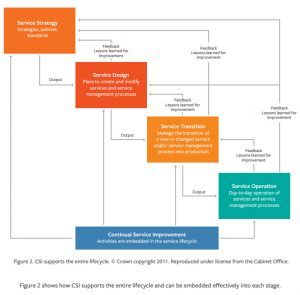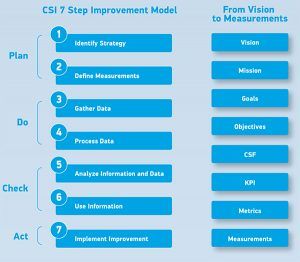ITIL 4 Continual Improvement ›
What is Continual Service Improvement?
Continual Service Improvement (CSI) uses a metrics-driven approach to identifying opportunities for improvement and to measure the impact of improvement efforts. Although CSI is a phase of the lifecycle and is documented in a separate ITIL publication, CSI can be effective only if it is integrated throughout the lifecycle, creating a culture of continual improvement. CSI should ensure that all participants in service delivery understand that identifying opportunities for improvement is their responsibility.
An important task for CSI is to identify which metrics out of the thousands that are created daily should be monitored. This is done by identifying, for each service or process, what the critical success factors (CSFs) are. CSFs must be present if a process or service is to succeed. It is recommended that each process or service have identified no more than three to five CSFs (one or two in the early life of a service or process).
To determine whether CSFs are present, it is necessary to identify key performance indicators (KPIs) that represent the degree to which the CSF is present. Again, it is recommended that each CSF be measured by no more than three to five KPIs (one or two in the early life of a service or process). It’s important to keep in mind that, although most KPIs are quantitative, qualitative KPIs, such as customer satisfaction, need to be considered as well.
Download Now: ITIL 4 Best Practice e-Books
These all-new for 2020 ITIL e-books highlight important elements of ITIL 4 best practices. Quickly understand key changes and actionable concepts, written by ITIL 4 contributors.
CSI is based on the Plan-Do-Check-Act approach developed by W. Edwards Deming. This is implemented in the CSI approach, as follows:
- What is the vision? What is our long-term objective?
- Where are we now? What are the current values of our KPIs?
- Where do we want to be? What are the desired KPI values?
- How do we get there? What’s the plan?
- Did we get there? Do the KPI values after implementation of the plan meet our objectives?
- How do we keep up the momentum? Let’s go back to the beginning.
CSI uses a 7-step process to guide how data is collected and used:
- Define the objectives.
- Determine what to measure.
- Collect the data.
- Process the data.
- Analyze the data.
- Present and use the information.
- Implement improvement.
If CSI is performing its role properly, there will be improvement suggestions arising from all parts of service delivery. The organization is unlikely to have enough resources to implement all of the suggestions, so it is necessary to capture the improvement opportunities, understand their impact, scope, and resource requirements, and prioritize their implementation. CSI uses the CSI register as a tool to document, analyze, and plan for improvements.
As businesses depend more on IT services, it is vital that IT organizations continually evaluate and improve their IT services and the IT service management processes that enable those IT services. A formal, proactive continual service improvement (CSI) practice is required to meet and achieve service level agreements.
To implement CSI, organizations need to instill the right attitude and drive the right behaviors until they become second nature. IT providers must embed a culture of measurement that continually tests the value, quality, performance, and compliance of the services within their portfolio and implements improvement initiatives that enable the desired business outcomes.
By definition, alignment requires bringing together two separate entities, often with disparate goals and objectives. However, in today’s complex IT environment, it is becoming more difficult to determine the difference between an IT service and a business service.
As the lines blur, alignment is no longer enough; IT must become an integral part of the business. Rather than having two separate organizations with disconnected goals and objectives, there must be a single, integrated business operation that functions with appropriate technology.
Many people have a personal continual improvement plan (although they may not call it that). For example, perhaps they decide they want to become more physically fit. First, they must define what “more physically fit” means to them. Then they measure their current fitness level and set goals for where they want to be. They may then decide to start walking half a mile every morning. Once they accomplish that for two weeks, they might increase the distance to one mile. After a month of walking one mile, they might increase the distance to a mile and a half, and so on. They measure their progress at regular intervals to determine where they are in relation to their goals. Once they meet their physical fitness goals, they select something else in their lives that they want to improve, and the improvement process begins again.
CSI for IT is just that: finding an IT area that is important to the business and looking for ways to improve it. ITIL defines CSI as “[a] stage in the lifecycle of a service. CSI ensures that you align services with changing business needs by identifying and implementing improvements to IT services that support business processes. You continually measure the performance of the IT service provider and then make improvements to processes, services, and infrastructure to increase efficiency and effectiveness.
CSI is a guiding factor and key focus in the new ITIL Practitioner program, launched in February 2016.
The service management lifecycle
The service lifecycle approach includes four key stages:
- Service strategy is about designing, developing, and implementing service management as both an organizational capability and a strategic asset.
- Service design focuses on ensuring IT services offerings fulfill the objectives of the business and the customer.
- Service transition centers on risk management, knowledge management, change management, service asset and configuration management, and related areas. Service transition creates a smooth ride from strategy, design, and development to operation.
- Service operation strives to manage operational priorities, such as availability of IT services. Improving the user experience and the quality of existing IT services is at the heart of the value delivered by CSI. While the other four stages are best performed with agility, CSI is most effective when you embed it in each of these lifecycle stages.

Why ITIL Continual Service Improvement?
Continual Service Improvement is the fifth publication in the ITIL series, but don’t take this to mean that this is the last stage of the ITIL lifecycle. Rather, it should be an integral part of every stage. If you have areas needing improvement, you can follow the CSI process, enjoy some quick wins, and demonstrate to the business that it can trust IT. This will open doors and enable you to start working with the business on further strategic initiatives, which, of course, is the service strategy component of the ITIL lifecycle.
Summary
Implement a CSI program so that you can take optimal advantage of your IT capabilities and resources. Find ways to make IT even more efficient, beneficial, and cost-effective so that it can continue to drive business value. CSI will also help you demonstrate value with metrics. By implementing a CSI program, you can develop baselines and maturity assessments.
7-step improvement process
The 7-step improvement process in ITIL is integrated with the Deming Cycle and the DIKW (Data-Information-Knowledge-Wisdom) model. Improvement can be made across the ITIL lifecycle with each stage of the lifecycle support giving feedback to the other stages for collaborative coordinated improvements.

- Identify the strategy for improvement
- Define metrics
- Gather data
- Process data
- Analyze data
- Use the data for improvement decisions
- Implement improvements
Special attention should be given to economic value of improvements, because all organizations have to recover cost for service delivered in order to exist. Financial management concepts and metrics pertaining to ROI, TCO, VOI, and ROA help here.








